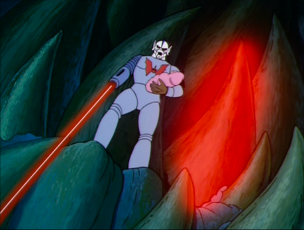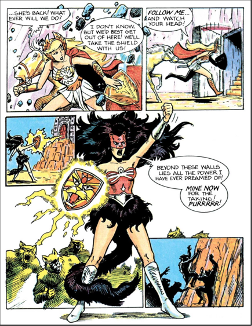In interviews she gave for the launch of the Netflix/DreamWorks series She-Ra and the Princesses of Power (2018—2020), showrunner Noelle Stevenson made the point repeatedly: the new She-Ra would be the same, but different. From the beginning, the show was conceived not as a sequel or prequel to the original Filmation series (1985—1986), but as a reboot. This, Stevenson explained, gave her and her team the freedom to make changes to the property at numerous levels, including character visualization (She-Ra’s bike shorts), character diversity and scripting (the emphasis on body positive and LBGTQ characters), and animation style (animators now drew heavily on anime). And yet story-wise, the new show would not totally erase the Filmation original—it would be a soft rather than hard reboot. The creative process behind She-Ra and the Princesses of Power was one of overt narrative sourcing, modernization, and expansion—of carefully positioning the new series as a refractive retelling of the 1980s show. Stevenson explained how working with Netflix facilitated this approach:
[With Netflix streaming] we get to be very serialized and have a lot of continuity, which means we have a lot of over-arching plots, and we have a lot of mythology. That’s also something that is present in the original, but we get to be a little bit more overt with it—we get to play with it a little bit more than a show on a network would traditionally be able to. Because you’re not airing it all at one time, it might air out of order. So, being able to air it and know that people are going to watch several episodes at a time, most likely, was a really, really fun exercise in developing a story for TV (Stevenson in Jackson 2018).
If the term “reboot” helps us understand certain aspects of She-Ra and the Princesses of Power, it can in some respects seem rather limiting. Calling Stevenson’s show a reboot really doesn’t tell us how it fits into the larger configuration of stories and continuities that constitutes the She-Ra property. How might we describe She-Ra globally, as a cross-media narrative experience? I would like to propose a different term. Taken as a whole—as a series of series (a 93-episode syndicated broadcast show, a 52-episode web show, and a set of comic books, minicomics, graphic novels, chapter plays, and so on)—She-Ra hangs together through its threaded media storytelling.
The principles behind this strategy are simple enough. I use “threaded”—a computer science term for when several distinct programs are running simultaneously—to refer here to a franchise that releases two or more medium-specific continuities at the same time. But there is a catch. These continuities do not reinforce, connect to, or build on one another. Rather, each medium recognizably refracts certain “core” story elements to construct its very own iteration of the same continuing adventure (of a heroine or hero).
The franchise’s narrative grows but in a manner different from the transmedia storytelling of properties like Disney/Lucasfilm’s Star Wars Rebels series (2014—2018). Franchises that tell transmedia stories enlist multiple media to create a single, relatively unified narrative experience, with each medium chipping in a piece of the larger metapuzzle. Not so with a threaded media franchise. Its narrative evolves as a poly-canon of official series that tell and retell the same continuities, dynamically stretching and condensing them as context demands. Threaded franchises generate interest by releasing several little narrative puzzles at once. The pieces that comprise these mini puzzles often seem identical, but new pieces can be introduced, causing familiar pieces to fit together differently. And there is ultimately no metapuzzle to assemble—no single transmedia plotline for story-followers to construct.
She-Ra, I would argue, is a system of discrete but similar mini puzzles, a threaded configuration of medium-specific iterations of one familiar story continuity. Longtime followers of the franchise know that the “original” She-Ra wasn’t just a TV show or a set of action figures. From the get-go, the show told one version of She-Ra’s origins and the minicomics accompanying the action figures told another. Kids like me were given the opportunity to imagine She-Ra’s beginnings twice—we had two narrative puzzles to solve side by side.

part 4 of “The Secret of She-Ra” (1985).
The plot of Filmation’s debut mini-series, the five-part “The Secret of She-Ra” (9 September—13 September 1985), emphasized a divided family (that of King Randor and Queen Marlena, the royal family of Eternia) as well as kidnapping and surrogate parentage (Hordak fled to Etheria with Adora, the daughter of Randor and Marlena, raising and brainwashing her) (Figure 1). But we also find inextinguishable sibling love (between She-Ra/Adora and He-Man/Adam), self-discovery (Adora coming to terms with her past), and coming-of-age (Adora discovering her powers and responsibilities as She-Ra and leading the Kingdom of Bright Moon’s liberation from Hordak’s Evil Horde).

He-Man and She-Ra: The Secret of the Sword.
The eight-year old me was infatuated with the story and rented the VHS tape compiling the episodes (renamed He-Man and She-Ra: The Secret of the Sword)more times than I can recall (Figure 2). I remember it coming as something of a surprise when, sometime after seeing the mini-series, my parents finally acceded to my no-doubt constant pestering and purchased a few She-Ra action figures for my Masters of the Universe collection, and I discovered in the accompanying Mattel/POP minicomic a different origin story. It was called Princess of Power: The Story of She-Ra (1984). The plot didn’t strike me as lesser or “wrong.” It was just different—but the same. In this version, Hordak kidnapped baby Adora (Figure 3), and Adora eventually learned that He-Man was her long-lost brother, but the Horde and the separation from the King and Queen were abandoned, and emphasis was instead placed on Adora’s conflict with the villain Catra. Some aspects of the Filmation origin story were thus revised and condensed, others elaborated. Catra appeared in the Filmation series. But the minicomics gave her a larger role. Hooked, I wanted more action figures to see how the plot developed (more a “cumulative” than a “serial,” the minicomics recounted the slowly evolving rivalry between She-Ra and Catra) (Figure 4).


In some ways anticipating Stevenson’s She-Ra and the Princesses of Power, albeit in much simpler form, the 1984 minicomic stressed female protagonists and dynamics (Adora/She-Ra and Catra). And like the Stevenson reboot, She-Ra’s identity wasn’t a secret. Characters in the minicomic knew that Adora and She-Ra were one and the same.
We wouldn’t want to press this comparison too far. Stevenson’s series is much more developed and sophisticated in terms of characterization and storytelling. Neither Catra nor She-Ra had much depth in the minicomic origin story, and their relationship was limited to action set pieces with Catra serving as the evil force Adora must defeat to come into her own as her alter-ego She-Ra.
Nevertheless, this brief comparison of She-Ra stories shows threaded media storytelling at work. It’s an efficient solution to the problem of having to produce new content and foster consumer loyalty. Cross-media story-followers are given new story arcs, but they are based on familiar tropes. This process continually renews interest, but in a specific way, by stimulating obsessive comparative re-reading (and re-viewing). As a threaded property, the original She-Ra gave us two concurrent iterations to juxtapose.
The story doesn’t end there (obviously). Over time the She-Ra property has shown that the strategy of threading can be adapted to releases that are not concurrent. The case could be made, in other words, that She-Ra and the Princesses of Power demands attention as a form of consecutive threaded production. It encourages us to enjoy the commonalities and deviations among competing continuities released in distinct media years and even decades apart.

He-Man and the Masters of the Universe.
Sharing the market with re-issues of the mini-comics (see Figure 5) and the original She-Ra series (via Comixology and Amazon, respectively), Stevenson’s version doesn’t just reboot an old TV show. A revival and expansion of aspects of the 1980s minicomic, it also lives alongside other continuities through a system of re-releases. She-Ra and the Princesses of Power demonstrates the drive—characteristic of franchises that thread their stories—to “play” (Stevenson’s term) with the full range of previously recounted tales, using new platforms, formats, and techniques to solicit us to discover in old continuities “dormant” or undeveloped things that were already there but perhaps went unnoticed or untapped.
References
Jackson, Chelsea (2018), “Showrunner Noelle Stevenson Gave Us the Rundown on Everything She-Ra,” The Mary Sue, https://www.themarysue.com/she-ra-princesses-power-noelle-stevenson-interview/ [Accessed June 2, 2020].
Colin Burnett is Associate Professor of Film and Media Studies at Washington University in St. Louis. He is the author of two books, on the history of professional wrestling and the cinema of Robert Bresson. He has written numerous articles on film style and storytelling, covering such topics as film authorship, French animation and documentary, and the art cinemas of India and Taiwan, and is currently at work on a third book that elaborates on the concept of threaded media storytelling, entitled Serial Bonds: The Multimedia Life of 007.

5 comments for “She-Ra and the Principles of Threaded Media Storytelling”